Measuring Employee Performance
VerifiedAdded on 2020/11/23
|14
|4254
|322
Essay
AI Summary
This assignment focuses on the topic of employee performance measurement. It delves into different methods and strategies used to assess employee effectiveness, highlighting their advantages and limitations. The discussion encompasses a range of approaches, from traditional methods like performance appraisals to more modern techniques such as 360-degree feedback and competency-based assessments. Students are encouraged to analyze the various tools available for measuring performance and evaluate their suitability for different organizational contexts.
Contribute Materials
Your contribution can guide someone’s learning journey. Share your
documents today.
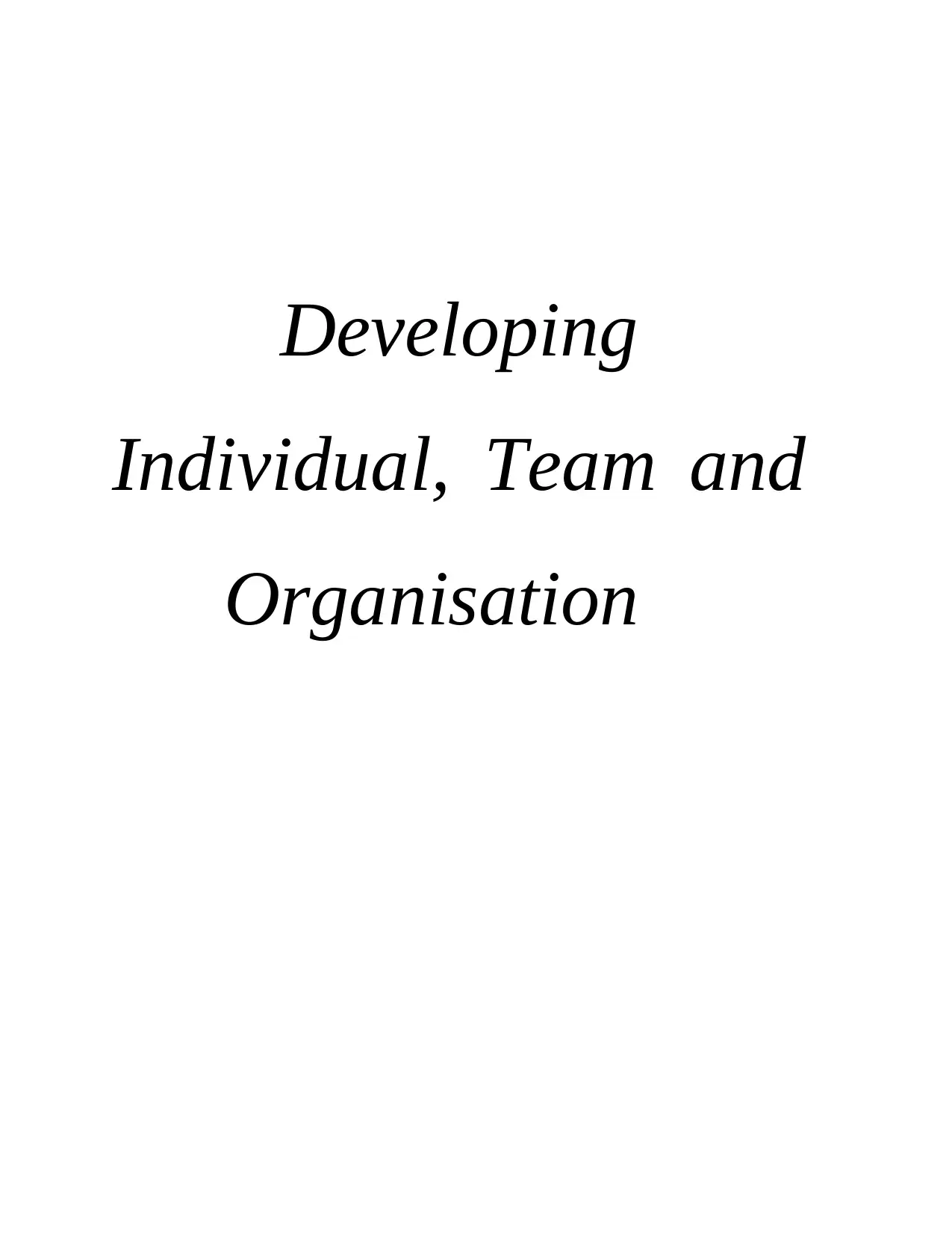
Developing
Individual, Team and
Organisation
Individual, Team and
Organisation
Secure Best Marks with AI Grader
Need help grading? Try our AI Grader for instant feedback on your assignments.
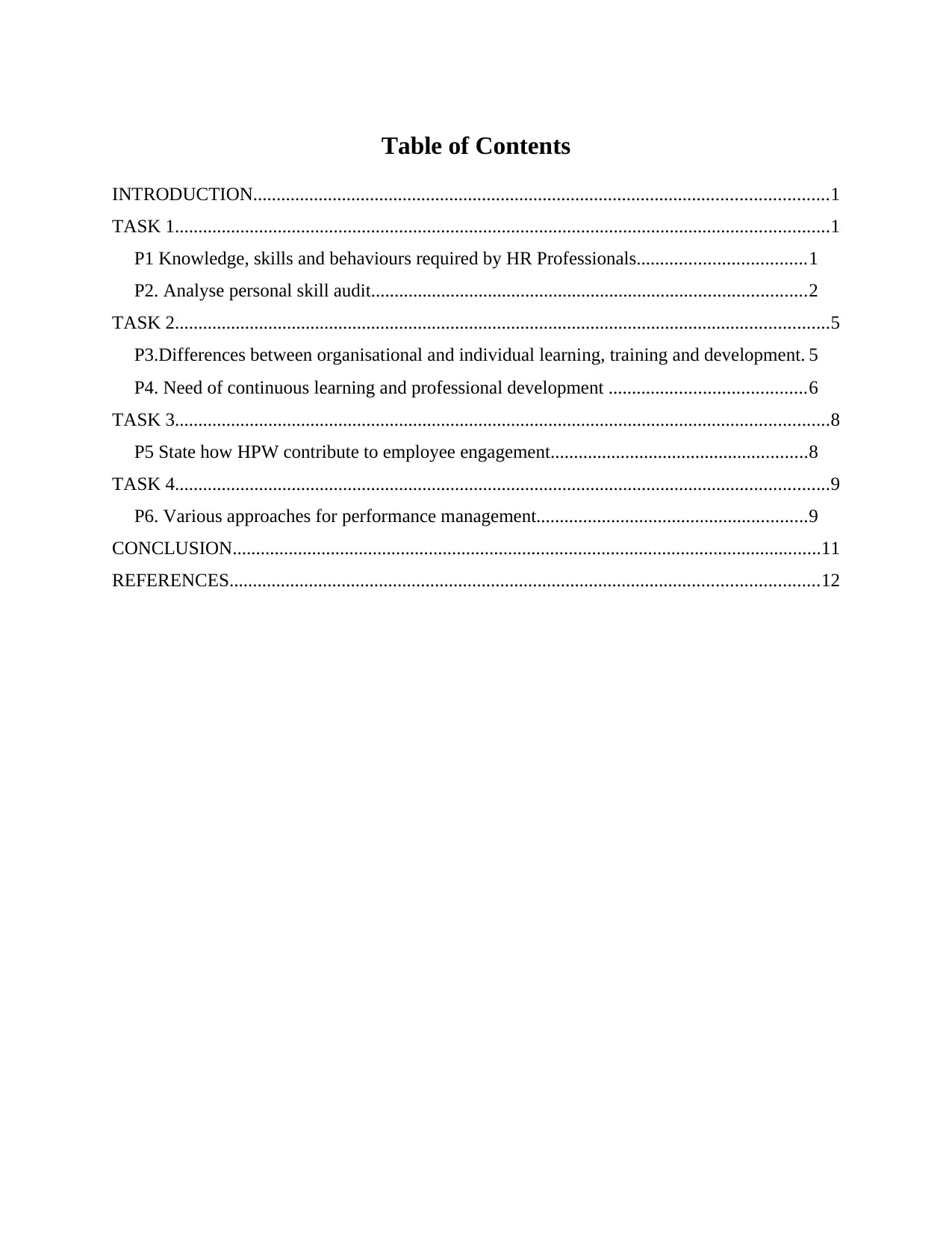
Table of Contents
INTRODUCTION...........................................................................................................................1
TASK 1............................................................................................................................................1
P1 Knowledge, skills and behaviours required by HR Professionals....................................1
P2. Analyse personal skill audit.............................................................................................2
TASK 2............................................................................................................................................5
P3.Differences between organisational and individual learning, training and development. 5
P4. Need of continuous learning and professional development ..........................................6
TASK 3............................................................................................................................................8
P5 State how HPW contribute to employee engagement.......................................................8
TASK 4............................................................................................................................................9
P6. Various approaches for performance management..........................................................9
CONCLUSION..............................................................................................................................11
REFERENCES..............................................................................................................................12
INTRODUCTION...........................................................................................................................1
TASK 1............................................................................................................................................1
P1 Knowledge, skills and behaviours required by HR Professionals....................................1
P2. Analyse personal skill audit.............................................................................................2
TASK 2............................................................................................................................................5
P3.Differences between organisational and individual learning, training and development. 5
P4. Need of continuous learning and professional development ..........................................6
TASK 3............................................................................................................................................8
P5 State how HPW contribute to employee engagement.......................................................8
TASK 4............................................................................................................................................9
P6. Various approaches for performance management..........................................................9
CONCLUSION..............................................................................................................................11
REFERENCES..............................................................................................................................12
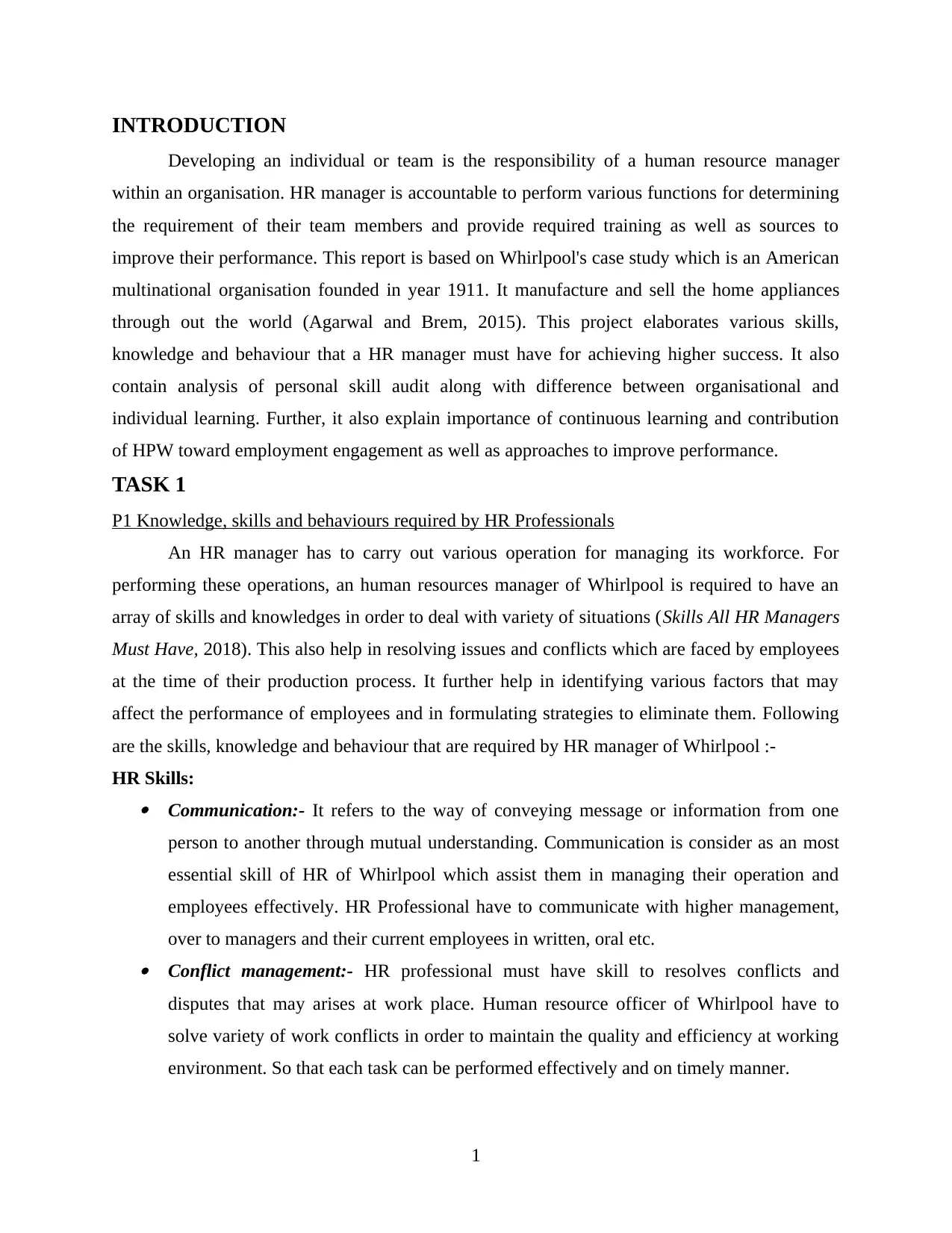
INTRODUCTION
Developing an individual or team is the responsibility of a human resource manager
within an organisation. HR manager is accountable to perform various functions for determining
the requirement of their team members and provide required training as well as sources to
improve their performance. This report is based on Whirlpool's case study which is an American
multinational organisation founded in year 1911. It manufacture and sell the home appliances
through out the world (Agarwal and Brem, 2015). This project elaborates various skills,
knowledge and behaviour that a HR manager must have for achieving higher success. It also
contain analysis of personal skill audit along with difference between organisational and
individual learning. Further, it also explain importance of continuous learning and contribution
of HPW toward employment engagement as well as approaches to improve performance.
TASK 1
P1 Knowledge, skills and behaviours required by HR Professionals
An HR manager has to carry out various operation for managing its workforce. For
performing these operations, an human resources manager of Whirlpool is required to have an
array of skills and knowledges in order to deal with variety of situations (Skills All HR Managers
Must Have, 2018). This also help in resolving issues and conflicts which are faced by employees
at the time of their production process. It further help in identifying various factors that may
affect the performance of employees and in formulating strategies to eliminate them. Following
are the skills, knowledge and behaviour that are required by HR manager of Whirlpool :-
HR Skills: Communication:- It refers to the way of conveying message or information from one
person to another through mutual understanding. Communication is consider as an most
essential skill of HR of Whirlpool which assist them in managing their operation and
employees effectively. HR Professional have to communicate with higher management,
over to managers and their current employees in written, oral etc. Conflict management:- HR professional must have skill to resolves conflicts and
disputes that may arises at work place. Human resource officer of Whirlpool have to
solve variety of work conflicts in order to maintain the quality and efficiency at working
environment. So that each task can be performed effectively and on timely manner.
1
Developing an individual or team is the responsibility of a human resource manager
within an organisation. HR manager is accountable to perform various functions for determining
the requirement of their team members and provide required training as well as sources to
improve their performance. This report is based on Whirlpool's case study which is an American
multinational organisation founded in year 1911. It manufacture and sell the home appliances
through out the world (Agarwal and Brem, 2015). This project elaborates various skills,
knowledge and behaviour that a HR manager must have for achieving higher success. It also
contain analysis of personal skill audit along with difference between organisational and
individual learning. Further, it also explain importance of continuous learning and contribution
of HPW toward employment engagement as well as approaches to improve performance.
TASK 1
P1 Knowledge, skills and behaviours required by HR Professionals
An HR manager has to carry out various operation for managing its workforce. For
performing these operations, an human resources manager of Whirlpool is required to have an
array of skills and knowledges in order to deal with variety of situations (Skills All HR Managers
Must Have, 2018). This also help in resolving issues and conflicts which are faced by employees
at the time of their production process. It further help in identifying various factors that may
affect the performance of employees and in formulating strategies to eliminate them. Following
are the skills, knowledge and behaviour that are required by HR manager of Whirlpool :-
HR Skills: Communication:- It refers to the way of conveying message or information from one
person to another through mutual understanding. Communication is consider as an most
essential skill of HR of Whirlpool which assist them in managing their operation and
employees effectively. HR Professional have to communicate with higher management,
over to managers and their current employees in written, oral etc. Conflict management:- HR professional must have skill to resolves conflicts and
disputes that may arises at work place. Human resource officer of Whirlpool have to
solve variety of work conflicts in order to maintain the quality and efficiency at working
environment. So that each task can be performed effectively and on timely manner.
1
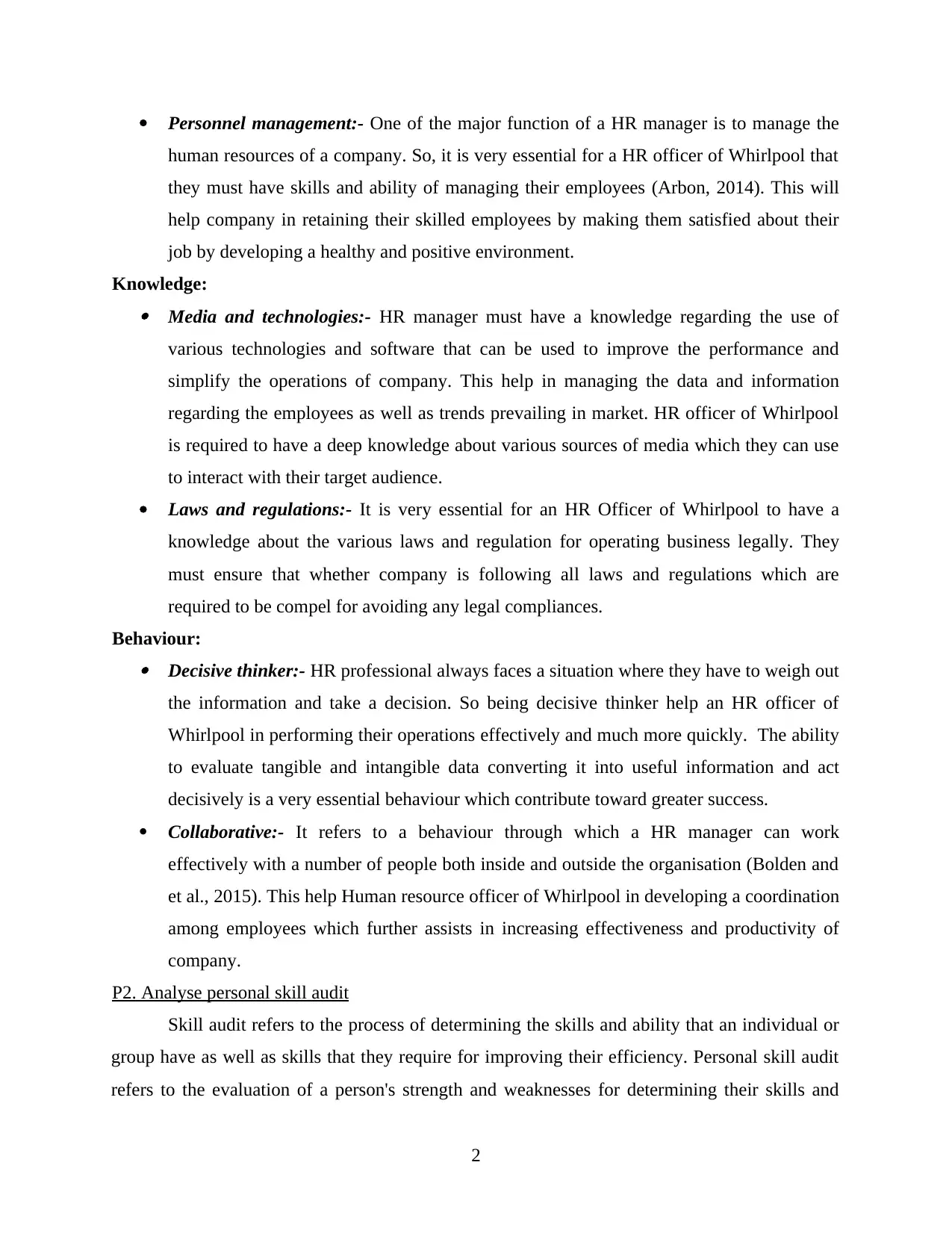
Personnel management:- One of the major function of a HR manager is to manage the
human resources of a company. So, it is very essential for a HR officer of Whirlpool that
they must have skills and ability of managing their employees (Arbon, 2014). This will
help company in retaining their skilled employees by making them satisfied about their
job by developing a healthy and positive environment.
Knowledge: Media and technologies:- HR manager must have a knowledge regarding the use of
various technologies and software that can be used to improve the performance and
simplify the operations of company. This help in managing the data and information
regarding the employees as well as trends prevailing in market. HR officer of Whirlpool
is required to have a deep knowledge about various sources of media which they can use
to interact with their target audience.
Laws and regulations:- It is very essential for an HR Officer of Whirlpool to have a
knowledge about the various laws and regulation for operating business legally. They
must ensure that whether company is following all laws and regulations which are
required to be compel for avoiding any legal compliances.
Behaviour: Decisive thinker:- HR professional always faces a situation where they have to weigh out
the information and take a decision. So being decisive thinker help an HR officer of
Whirlpool in performing their operations effectively and much more quickly. The ability
to evaluate tangible and intangible data converting it into useful information and act
decisively is a very essential behaviour which contribute toward greater success.
Collaborative:- It refers to a behaviour through which a HR manager can work
effectively with a number of people both inside and outside the organisation (Bolden and
et al., 2015). This help Human resource officer of Whirlpool in developing a coordination
among employees which further assists in increasing effectiveness and productivity of
company.
P2. Analyse personal skill audit
Skill audit refers to the process of determining the skills and ability that an individual or
group have as well as skills that they require for improving their efficiency. Personal skill audit
refers to the evaluation of a person's strength and weaknesses for determining their skills and
2
human resources of a company. So, it is very essential for a HR officer of Whirlpool that
they must have skills and ability of managing their employees (Arbon, 2014). This will
help company in retaining their skilled employees by making them satisfied about their
job by developing a healthy and positive environment.
Knowledge: Media and technologies:- HR manager must have a knowledge regarding the use of
various technologies and software that can be used to improve the performance and
simplify the operations of company. This help in managing the data and information
regarding the employees as well as trends prevailing in market. HR officer of Whirlpool
is required to have a deep knowledge about various sources of media which they can use
to interact with their target audience.
Laws and regulations:- It is very essential for an HR Officer of Whirlpool to have a
knowledge about the various laws and regulation for operating business legally. They
must ensure that whether company is following all laws and regulations which are
required to be compel for avoiding any legal compliances.
Behaviour: Decisive thinker:- HR professional always faces a situation where they have to weigh out
the information and take a decision. So being decisive thinker help an HR officer of
Whirlpool in performing their operations effectively and much more quickly. The ability
to evaluate tangible and intangible data converting it into useful information and act
decisively is a very essential behaviour which contribute toward greater success.
Collaborative:- It refers to a behaviour through which a HR manager can work
effectively with a number of people both inside and outside the organisation (Bolden and
et al., 2015). This help Human resource officer of Whirlpool in developing a coordination
among employees which further assists in increasing effectiveness and productivity of
company.
P2. Analyse personal skill audit
Skill audit refers to the process of determining the skills and ability that an individual or
group have as well as skills that they require for improving their efficiency. Personal skill audit
refers to the evaluation of a person's strength and weaknesses for determining their skills and
2
Secure Best Marks with AI Grader
Need help grading? Try our AI Grader for instant feedback on your assignments.
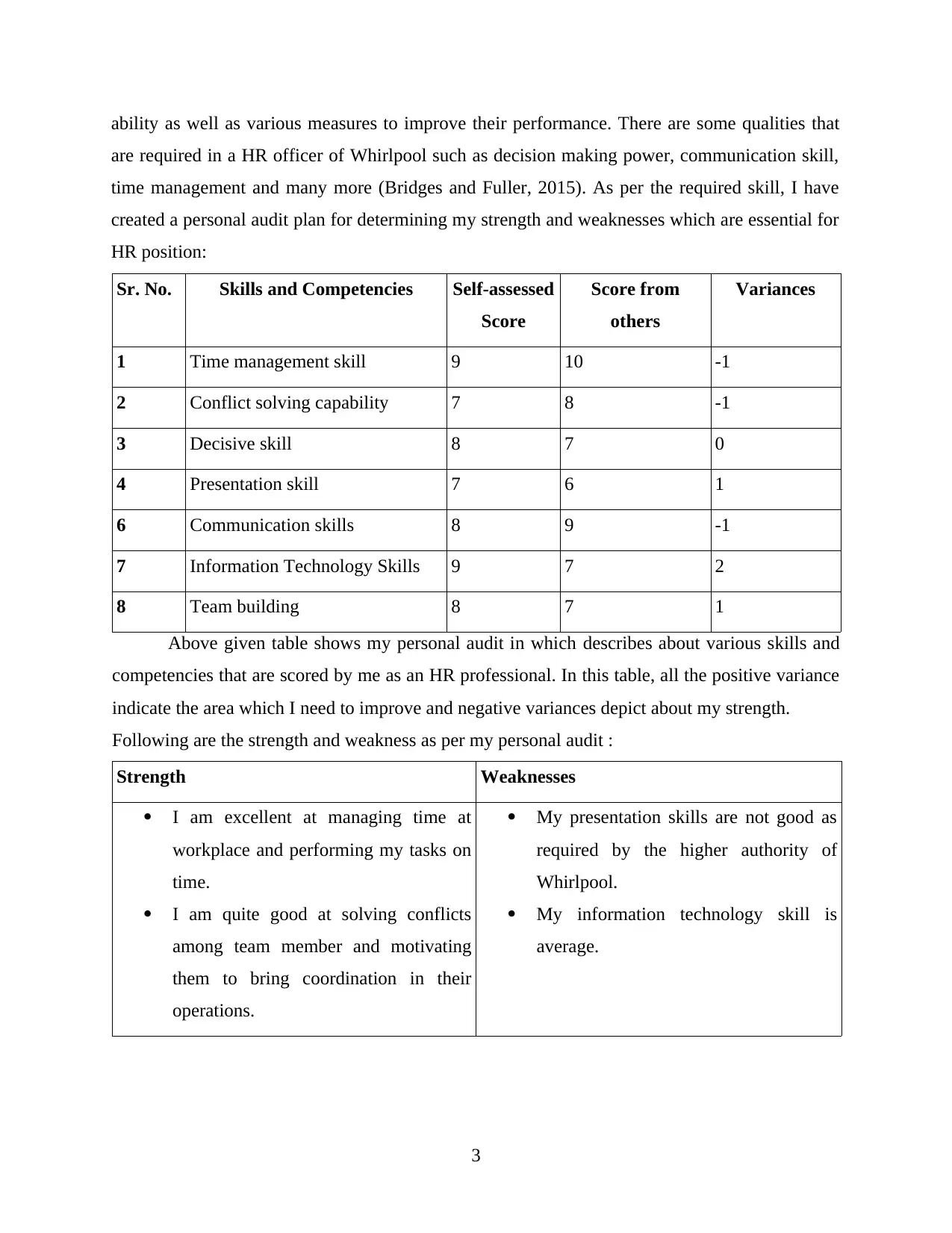
ability as well as various measures to improve their performance. There are some qualities that
are required in a HR officer of Whirlpool such as decision making power, communication skill,
time management and many more (Bridges and Fuller, 2015). As per the required skill, I have
created a personal audit plan for determining my strength and weaknesses which are essential for
HR position:
Sr. No. Skills and Competencies Self-assessed
Score
Score from
others
Variances
1 Time management skill 9 10 -1
2 Conflict solving capability 7 8 -1
3 Decisive skill 8 7 0
4 Presentation skill 7 6 1
6 Communication skills 8 9 -1
7 Information Technology Skills 9 7 2
8 Team building 8 7 1
Above given table shows my personal audit in which describes about various skills and
competencies that are scored by me as an HR professional. In this table, all the positive variance
indicate the area which I need to improve and negative variances depict about my strength.
Following are the strength and weakness as per my personal audit :
Strength Weaknesses
I am excellent at managing time at
workplace and performing my tasks on
time.
I am quite good at solving conflicts
among team member and motivating
them to bring coordination in their
operations.
My presentation skills are not good as
required by the higher authority of
Whirlpool.
My information technology skill is
average.
3
are required in a HR officer of Whirlpool such as decision making power, communication skill,
time management and many more (Bridges and Fuller, 2015). As per the required skill, I have
created a personal audit plan for determining my strength and weaknesses which are essential for
HR position:
Sr. No. Skills and Competencies Self-assessed
Score
Score from
others
Variances
1 Time management skill 9 10 -1
2 Conflict solving capability 7 8 -1
3 Decisive skill 8 7 0
4 Presentation skill 7 6 1
6 Communication skills 8 9 -1
7 Information Technology Skills 9 7 2
8 Team building 8 7 1
Above given table shows my personal audit in which describes about various skills and
competencies that are scored by me as an HR professional. In this table, all the positive variance
indicate the area which I need to improve and negative variances depict about my strength.
Following are the strength and weakness as per my personal audit :
Strength Weaknesses
I am excellent at managing time at
workplace and performing my tasks on
time.
I am quite good at solving conflicts
among team member and motivating
them to bring coordination in their
operations.
My presentation skills are not good as
required by the higher authority of
Whirlpool.
My information technology skill is
average.
3
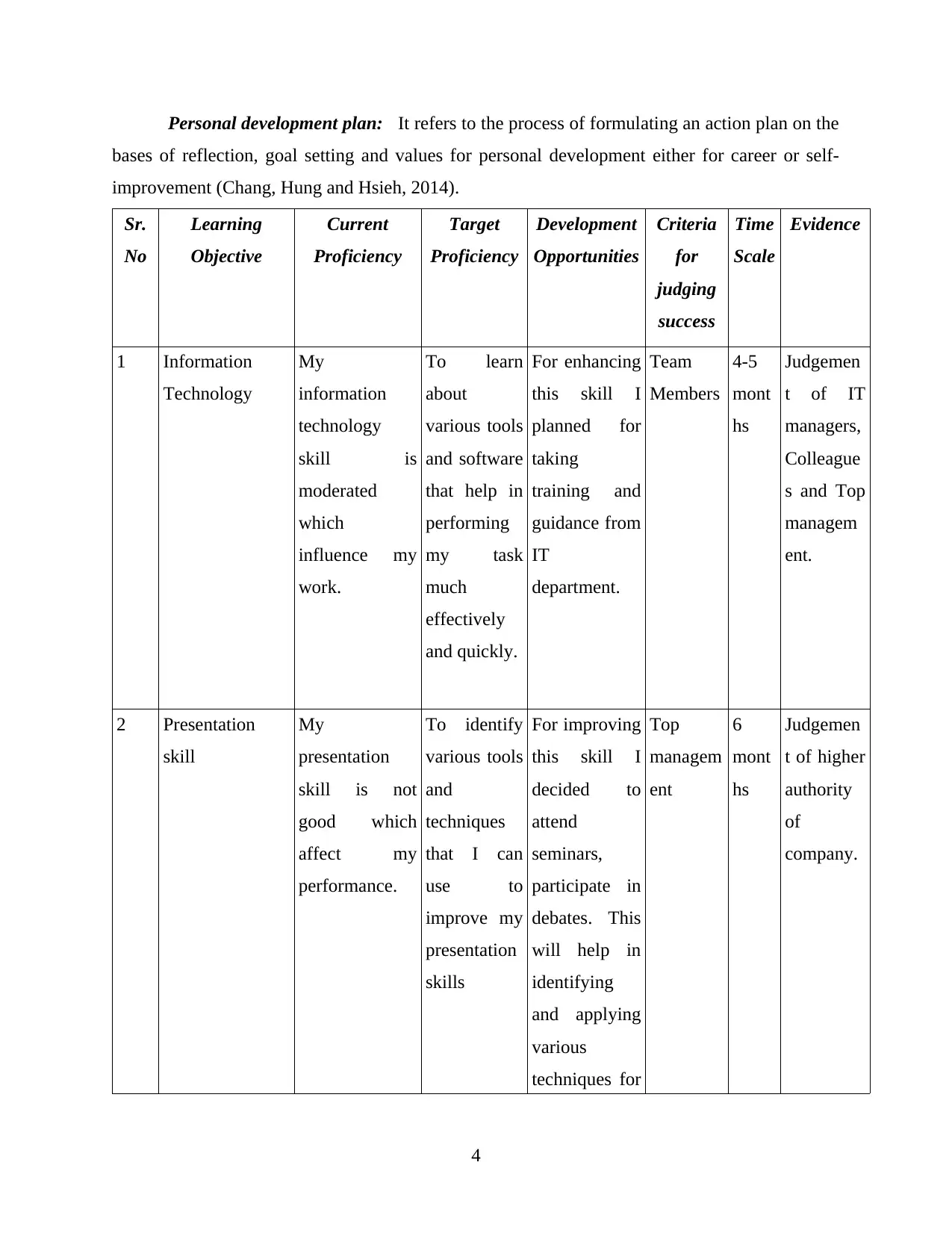
Personal development plan: It refers to the process of formulating an action plan on the
bases of reflection, goal setting and values for personal development either for career or self-
improvement (Chang, Hung and Hsieh, 2014).
Sr.
No
Learning
Objective
Current
Proficiency
Target
Proficiency
Development
Opportunities
Criteria
for
judging
success
Time
Scale
Evidence
1 Information
Technology
My
information
technology
skill is
moderated
which
influence my
work.
To learn
about
various tools
and software
that help in
performing
my task
much
effectively
and quickly.
For enhancing
this skill I
planned for
taking
training and
guidance from
IT
department.
Team
Members
4-5
mont
hs
Judgemen
t of IT
managers,
Colleague
s and Top
managem
ent.
2 Presentation
skill
My
presentation
skill is not
good which
affect my
performance.
To identify
various tools
and
techniques
that I can
use to
improve my
presentation
skills
For improving
this skill I
decided to
attend
seminars,
participate in
debates. This
will help in
identifying
and applying
various
techniques for
Top
managem
ent
6
mont
hs
Judgemen
t of higher
authority
of
company.
4
bases of reflection, goal setting and values for personal development either for career or self-
improvement (Chang, Hung and Hsieh, 2014).
Sr.
No
Learning
Objective
Current
Proficiency
Target
Proficiency
Development
Opportunities
Criteria
for
judging
success
Time
Scale
Evidence
1 Information
Technology
My
information
technology
skill is
moderated
which
influence my
work.
To learn
about
various tools
and software
that help in
performing
my task
much
effectively
and quickly.
For enhancing
this skill I
planned for
taking
training and
guidance from
IT
department.
Team
Members
4-5
mont
hs
Judgemen
t of IT
managers,
Colleague
s and Top
managem
ent.
2 Presentation
skill
My
presentation
skill is not
good which
affect my
performance.
To identify
various tools
and
techniques
that I can
use to
improve my
presentation
skills
For improving
this skill I
decided to
attend
seminars,
participate in
debates. This
will help in
identifying
and applying
various
techniques for
Top
managem
ent
6
mont
hs
Judgemen
t of higher
authority
of
company.
4
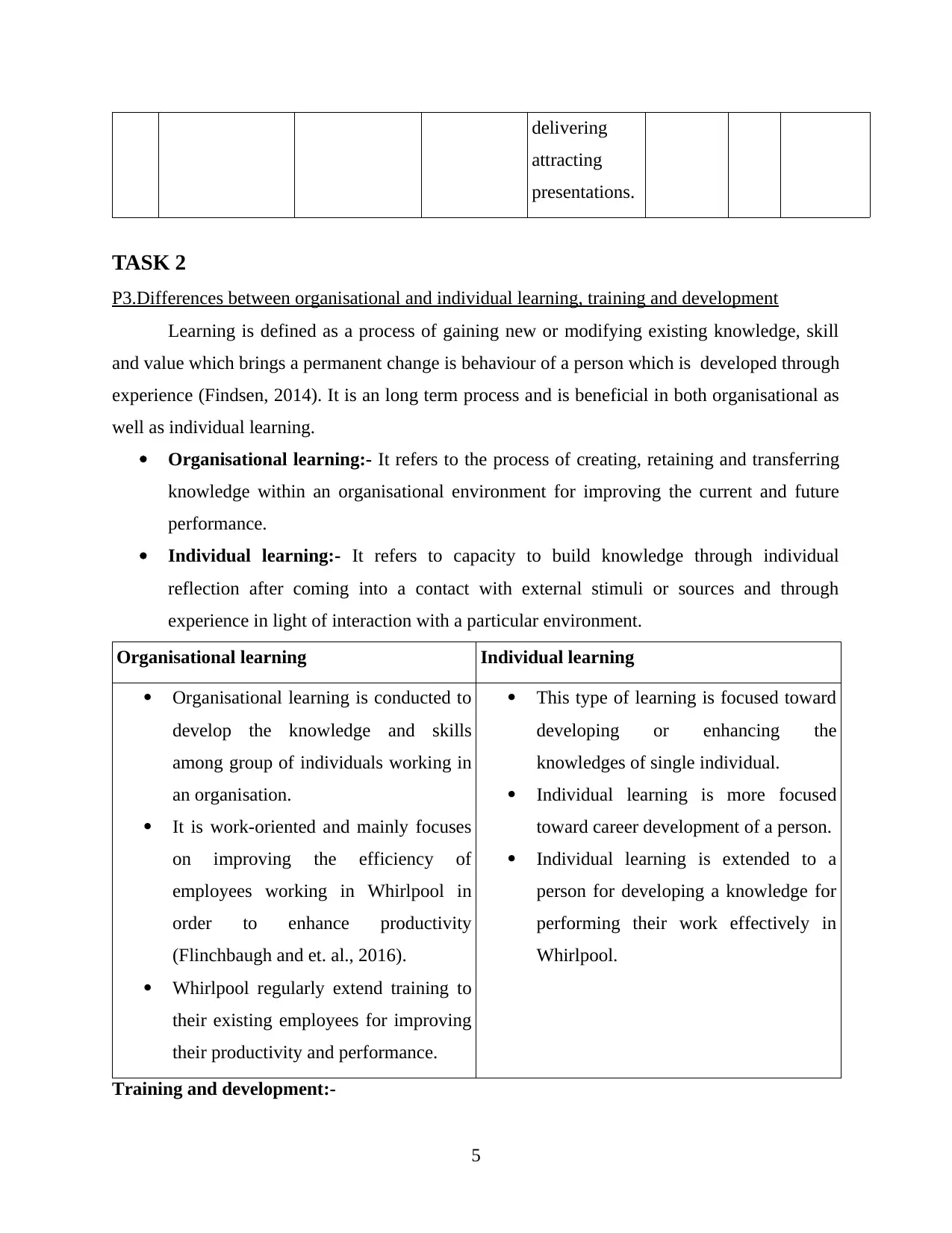
delivering
attracting
presentations.
TASK 2
P3.Differences between organisational and individual learning, training and development
Learning is defined as a process of gaining new or modifying existing knowledge, skill
and value which brings a permanent change is behaviour of a person which is developed through
experience (Findsen, 2014). It is an long term process and is beneficial in both organisational as
well as individual learning.
Organisational learning:- It refers to the process of creating, retaining and transferring
knowledge within an organisational environment for improving the current and future
performance.
Individual learning:- It refers to capacity to build knowledge through individual
reflection after coming into a contact with external stimuli or sources and through
experience in light of interaction with a particular environment.
Organisational learning Individual learning
Organisational learning is conducted to
develop the knowledge and skills
among group of individuals working in
an organisation.
It is work-oriented and mainly focuses
on improving the efficiency of
employees working in Whirlpool in
order to enhance productivity
(Flinchbaugh and et. al., 2016).
Whirlpool regularly extend training to
their existing employees for improving
their productivity and performance.
This type of learning is focused toward
developing or enhancing the
knowledges of single individual.
Individual learning is more focused
toward career development of a person.
Individual learning is extended to a
person for developing a knowledge for
performing their work effectively in
Whirlpool.
Training and development:-
5
attracting
presentations.
TASK 2
P3.Differences between organisational and individual learning, training and development
Learning is defined as a process of gaining new or modifying existing knowledge, skill
and value which brings a permanent change is behaviour of a person which is developed through
experience (Findsen, 2014). It is an long term process and is beneficial in both organisational as
well as individual learning.
Organisational learning:- It refers to the process of creating, retaining and transferring
knowledge within an organisational environment for improving the current and future
performance.
Individual learning:- It refers to capacity to build knowledge through individual
reflection after coming into a contact with external stimuli or sources and through
experience in light of interaction with a particular environment.
Organisational learning Individual learning
Organisational learning is conducted to
develop the knowledge and skills
among group of individuals working in
an organisation.
It is work-oriented and mainly focuses
on improving the efficiency of
employees working in Whirlpool in
order to enhance productivity
(Flinchbaugh and et. al., 2016).
Whirlpool regularly extend training to
their existing employees for improving
their productivity and performance.
This type of learning is focused toward
developing or enhancing the
knowledges of single individual.
Individual learning is more focused
toward career development of a person.
Individual learning is extended to a
person for developing a knowledge for
performing their work effectively in
Whirlpool.
Training and development:-
5
Paraphrase This Document
Need a fresh take? Get an instant paraphrase of this document with our AI Paraphraser
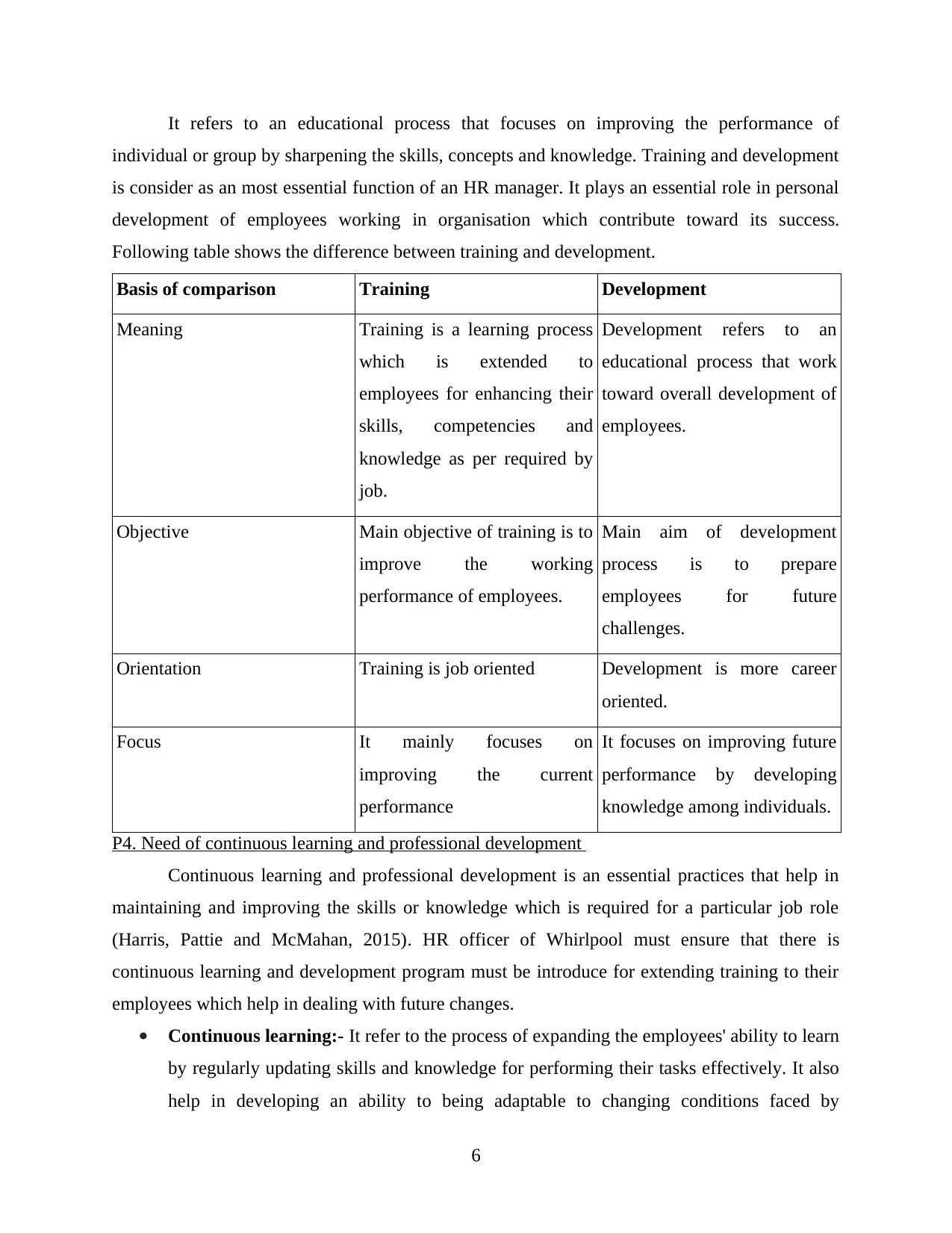
It refers to an educational process that focuses on improving the performance of
individual or group by sharpening the skills, concepts and knowledge. Training and development
is consider as an most essential function of an HR manager. It plays an essential role in personal
development of employees working in organisation which contribute toward its success.
Following table shows the difference between training and development.
Basis of comparison Training Development
Meaning Training is a learning process
which is extended to
employees for enhancing their
skills, competencies and
knowledge as per required by
job.
Development refers to an
educational process that work
toward overall development of
employees.
Objective Main objective of training is to
improve the working
performance of employees.
Main aim of development
process is to prepare
employees for future
challenges.
Orientation Training is job oriented Development is more career
oriented.
Focus It mainly focuses on
improving the current
performance
It focuses on improving future
performance by developing
knowledge among individuals.
P4. Need of continuous learning and professional development
Continuous learning and professional development is an essential practices that help in
maintaining and improving the skills or knowledge which is required for a particular job role
(Harris, Pattie and McMahan, 2015). HR officer of Whirlpool must ensure that there is
continuous learning and development program must be introduce for extending training to their
employees which help in dealing with future changes.
Continuous learning:- It refer to the process of expanding the employees' ability to learn
by regularly updating skills and knowledge for performing their tasks effectively. It also
help in developing an ability to being adaptable to changing conditions faced by
6
individual or group by sharpening the skills, concepts and knowledge. Training and development
is consider as an most essential function of an HR manager. It plays an essential role in personal
development of employees working in organisation which contribute toward its success.
Following table shows the difference between training and development.
Basis of comparison Training Development
Meaning Training is a learning process
which is extended to
employees for enhancing their
skills, competencies and
knowledge as per required by
job.
Development refers to an
educational process that work
toward overall development of
employees.
Objective Main objective of training is to
improve the working
performance of employees.
Main aim of development
process is to prepare
employees for future
challenges.
Orientation Training is job oriented Development is more career
oriented.
Focus It mainly focuses on
improving the current
performance
It focuses on improving future
performance by developing
knowledge among individuals.
P4. Need of continuous learning and professional development
Continuous learning and professional development is an essential practices that help in
maintaining and improving the skills or knowledge which is required for a particular job role
(Harris, Pattie and McMahan, 2015). HR officer of Whirlpool must ensure that there is
continuous learning and development program must be introduce for extending training to their
employees which help in dealing with future changes.
Continuous learning:- It refer to the process of expanding the employees' ability to learn
by regularly updating skills and knowledge for performing their tasks effectively. It also
help in developing an ability to being adaptable to changing conditions faced by
6
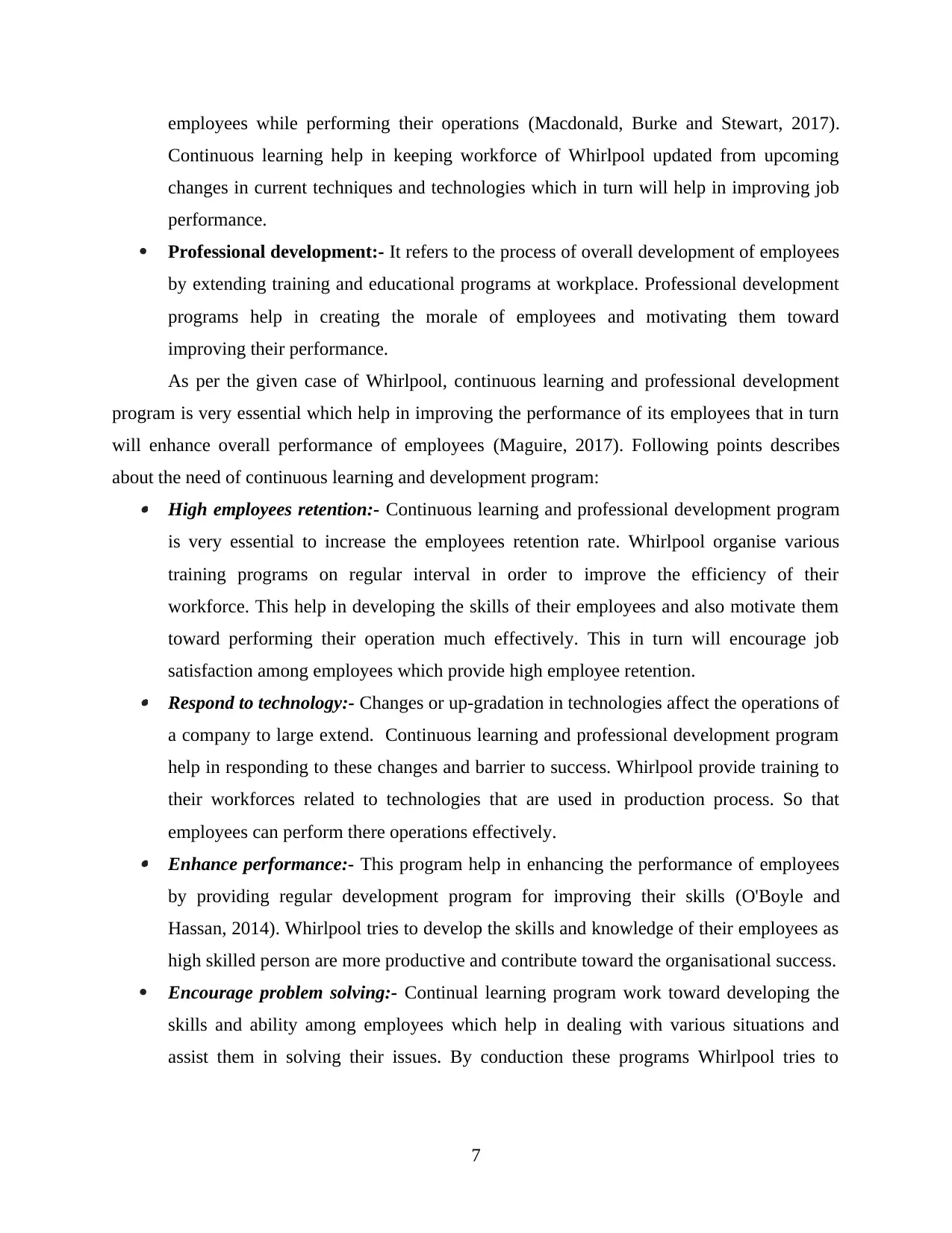
employees while performing their operations (Macdonald, Burke and Stewart, 2017).
Continuous learning help in keeping workforce of Whirlpool updated from upcoming
changes in current techniques and technologies which in turn will help in improving job
performance.
Professional development:- It refers to the process of overall development of employees
by extending training and educational programs at workplace. Professional development
programs help in creating the morale of employees and motivating them toward
improving their performance.
As per the given case of Whirlpool, continuous learning and professional development
program is very essential which help in improving the performance of its employees that in turn
will enhance overall performance of employees (Maguire, 2017). Following points describes
about the need of continuous learning and development program: High employees retention:- Continuous learning and professional development program
is very essential to increase the employees retention rate. Whirlpool organise various
training programs on regular interval in order to improve the efficiency of their
workforce. This help in developing the skills of their employees and also motivate them
toward performing their operation much effectively. This in turn will encourage job
satisfaction among employees which provide high employee retention. Respond to technology:- Changes or up-gradation in technologies affect the operations of
a company to large extend. Continuous learning and professional development program
help in responding to these changes and barrier to success. Whirlpool provide training to
their workforces related to technologies that are used in production process. So that
employees can perform there operations effectively. Enhance performance:- This program help in enhancing the performance of employees
by providing regular development program for improving their skills (O'Boyle and
Hassan, 2014). Whirlpool tries to develop the skills and knowledge of their employees as
high skilled person are more productive and contribute toward the organisational success.
Encourage problem solving:- Continual learning program work toward developing the
skills and ability among employees which help in dealing with various situations and
assist them in solving their issues. By conduction these programs Whirlpool tries to
7
Continuous learning help in keeping workforce of Whirlpool updated from upcoming
changes in current techniques and technologies which in turn will help in improving job
performance.
Professional development:- It refers to the process of overall development of employees
by extending training and educational programs at workplace. Professional development
programs help in creating the morale of employees and motivating them toward
improving their performance.
As per the given case of Whirlpool, continuous learning and professional development
program is very essential which help in improving the performance of its employees that in turn
will enhance overall performance of employees (Maguire, 2017). Following points describes
about the need of continuous learning and development program: High employees retention:- Continuous learning and professional development program
is very essential to increase the employees retention rate. Whirlpool organise various
training programs on regular interval in order to improve the efficiency of their
workforce. This help in developing the skills of their employees and also motivate them
toward performing their operation much effectively. This in turn will encourage job
satisfaction among employees which provide high employee retention. Respond to technology:- Changes or up-gradation in technologies affect the operations of
a company to large extend. Continuous learning and professional development program
help in responding to these changes and barrier to success. Whirlpool provide training to
their workforces related to technologies that are used in production process. So that
employees can perform there operations effectively. Enhance performance:- This program help in enhancing the performance of employees
by providing regular development program for improving their skills (O'Boyle and
Hassan, 2014). Whirlpool tries to develop the skills and knowledge of their employees as
high skilled person are more productive and contribute toward the organisational success.
Encourage problem solving:- Continual learning program work toward developing the
skills and ability among employees which help in dealing with various situations and
assist them in solving their issues. By conduction these programs Whirlpool tries to
7
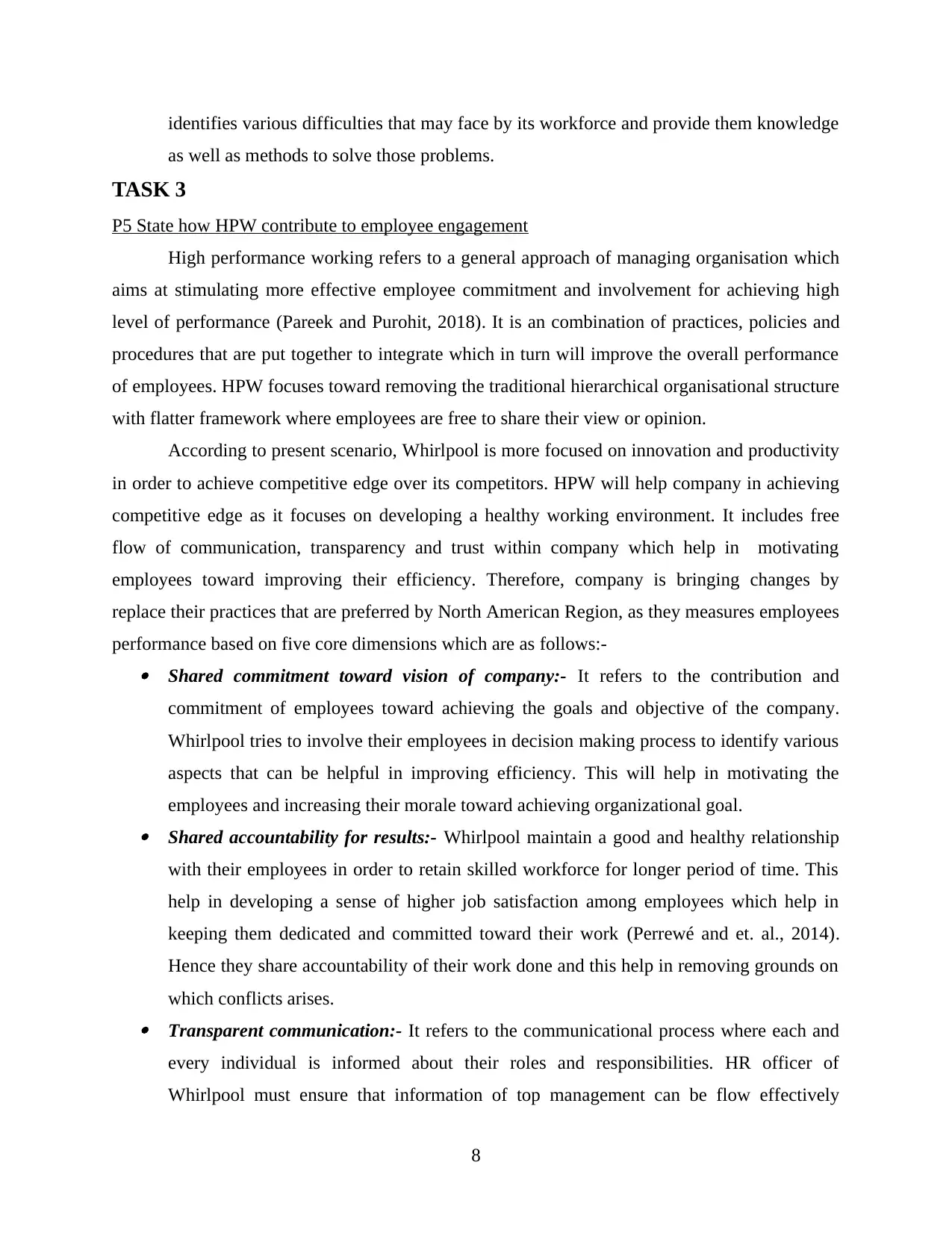
identifies various difficulties that may face by its workforce and provide them knowledge
as well as methods to solve those problems.
TASK 3
P5 State how HPW contribute to employee engagement
High performance working refers to a general approach of managing organisation which
aims at stimulating more effective employee commitment and involvement for achieving high
level of performance (Pareek and Purohit, 2018). It is an combination of practices, policies and
procedures that are put together to integrate which in turn will improve the overall performance
of employees. HPW focuses toward removing the traditional hierarchical organisational structure
with flatter framework where employees are free to share their view or opinion.
According to present scenario, Whirlpool is more focused on innovation and productivity
in order to achieve competitive edge over its competitors. HPW will help company in achieving
competitive edge as it focuses on developing a healthy working environment. It includes free
flow of communication, transparency and trust within company which help in motivating
employees toward improving their efficiency. Therefore, company is bringing changes by
replace their practices that are preferred by North American Region, as they measures employees
performance based on five core dimensions which are as follows:- Shared commitment toward vision of company:- It refers to the contribution and
commitment of employees toward achieving the goals and objective of the company.
Whirlpool tries to involve their employees in decision making process to identify various
aspects that can be helpful in improving efficiency. This will help in motivating the
employees and increasing their morale toward achieving organizational goal. Shared accountability for results:- Whirlpool maintain a good and healthy relationship
with their employees in order to retain skilled workforce for longer period of time. This
help in developing a sense of higher job satisfaction among employees which help in
keeping them dedicated and committed toward their work (Perrewé and et. al., 2014).
Hence they share accountability of their work done and this help in removing grounds on
which conflicts arises. Transparent communication:- It refers to the communicational process where each and
every individual is informed about their roles and responsibilities. HR officer of
Whirlpool must ensure that information of top management can be flow effectively
8
as well as methods to solve those problems.
TASK 3
P5 State how HPW contribute to employee engagement
High performance working refers to a general approach of managing organisation which
aims at stimulating more effective employee commitment and involvement for achieving high
level of performance (Pareek and Purohit, 2018). It is an combination of practices, policies and
procedures that are put together to integrate which in turn will improve the overall performance
of employees. HPW focuses toward removing the traditional hierarchical organisational structure
with flatter framework where employees are free to share their view or opinion.
According to present scenario, Whirlpool is more focused on innovation and productivity
in order to achieve competitive edge over its competitors. HPW will help company in achieving
competitive edge as it focuses on developing a healthy working environment. It includes free
flow of communication, transparency and trust within company which help in motivating
employees toward improving their efficiency. Therefore, company is bringing changes by
replace their practices that are preferred by North American Region, as they measures employees
performance based on five core dimensions which are as follows:- Shared commitment toward vision of company:- It refers to the contribution and
commitment of employees toward achieving the goals and objective of the company.
Whirlpool tries to involve their employees in decision making process to identify various
aspects that can be helpful in improving efficiency. This will help in motivating the
employees and increasing their morale toward achieving organizational goal. Shared accountability for results:- Whirlpool maintain a good and healthy relationship
with their employees in order to retain skilled workforce for longer period of time. This
help in developing a sense of higher job satisfaction among employees which help in
keeping them dedicated and committed toward their work (Perrewé and et. al., 2014).
Hence they share accountability of their work done and this help in removing grounds on
which conflicts arises. Transparent communication:- It refers to the communicational process where each and
every individual is informed about their roles and responsibilities. HR officer of
Whirlpool must ensure that information of top management can be flow effectively
8
Secure Best Marks with AI Grader
Need help grading? Try our AI Grader for instant feedback on your assignments.
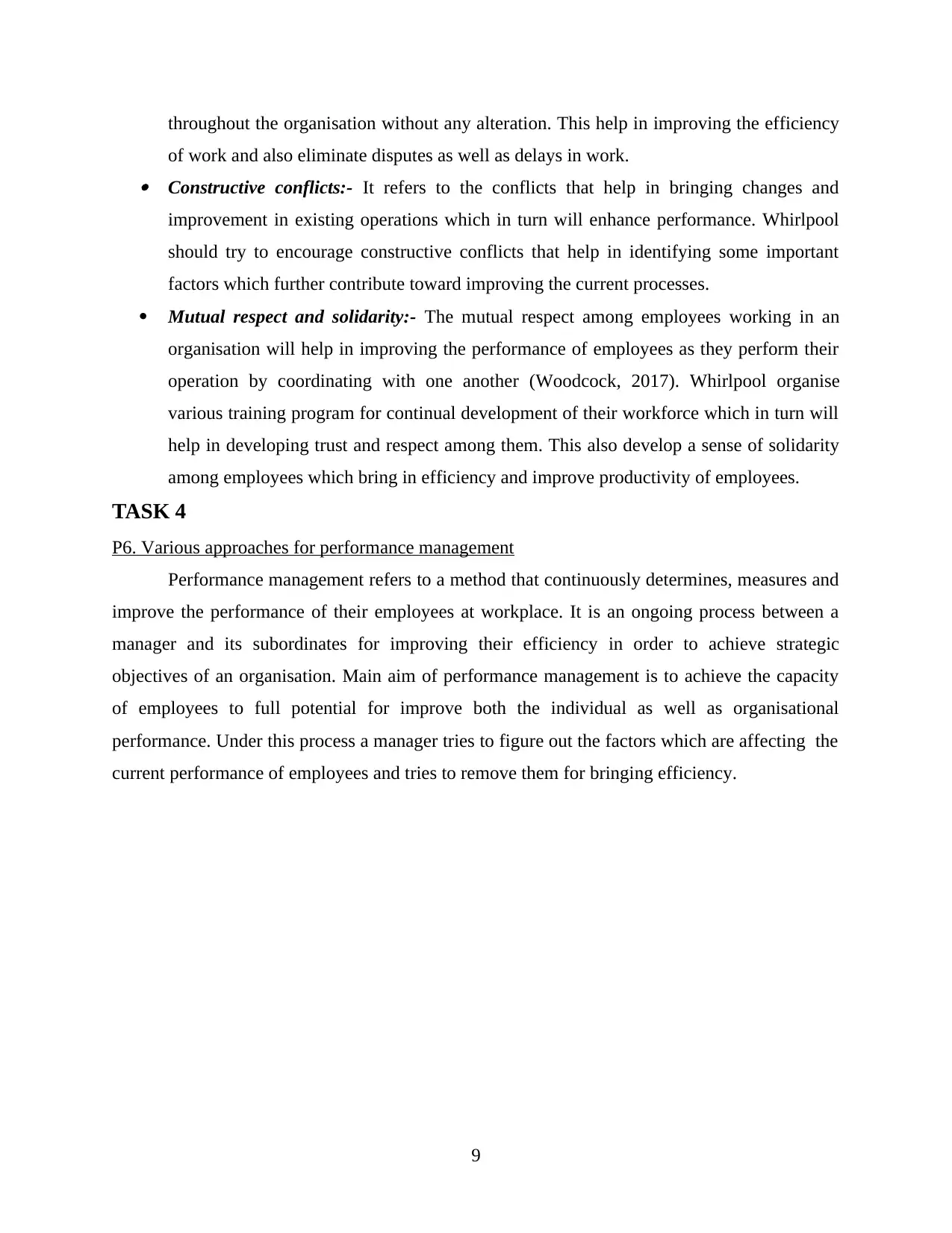
throughout the organisation without any alteration. This help in improving the efficiency
of work and also eliminate disputes as well as delays in work. Constructive conflicts:- It refers to the conflicts that help in bringing changes and
improvement in existing operations which in turn will enhance performance. Whirlpool
should try to encourage constructive conflicts that help in identifying some important
factors which further contribute toward improving the current processes.
Mutual respect and solidarity:- The mutual respect among employees working in an
organisation will help in improving the performance of employees as they perform their
operation by coordinating with one another (Woodcock, 2017). Whirlpool organise
various training program for continual development of their workforce which in turn will
help in developing trust and respect among them. This also develop a sense of solidarity
among employees which bring in efficiency and improve productivity of employees.
TASK 4
P6. Various approaches for performance management
Performance management refers to a method that continuously determines, measures and
improve the performance of their employees at workplace. It is an ongoing process between a
manager and its subordinates for improving their efficiency in order to achieve strategic
objectives of an organisation. Main aim of performance management is to achieve the capacity
of employees to full potential for improve both the individual as well as organisational
performance. Under this process a manager tries to figure out the factors which are affecting the
current performance of employees and tries to remove them for bringing efficiency.
9
of work and also eliminate disputes as well as delays in work. Constructive conflicts:- It refers to the conflicts that help in bringing changes and
improvement in existing operations which in turn will enhance performance. Whirlpool
should try to encourage constructive conflicts that help in identifying some important
factors which further contribute toward improving the current processes.
Mutual respect and solidarity:- The mutual respect among employees working in an
organisation will help in improving the performance of employees as they perform their
operation by coordinating with one another (Woodcock, 2017). Whirlpool organise
various training program for continual development of their workforce which in turn will
help in developing trust and respect among them. This also develop a sense of solidarity
among employees which bring in efficiency and improve productivity of employees.
TASK 4
P6. Various approaches for performance management
Performance management refers to a method that continuously determines, measures and
improve the performance of their employees at workplace. It is an ongoing process between a
manager and its subordinates for improving their efficiency in order to achieve strategic
objectives of an organisation. Main aim of performance management is to achieve the capacity
of employees to full potential for improve both the individual as well as organisational
performance. Under this process a manager tries to figure out the factors which are affecting the
current performance of employees and tries to remove them for bringing efficiency.
9
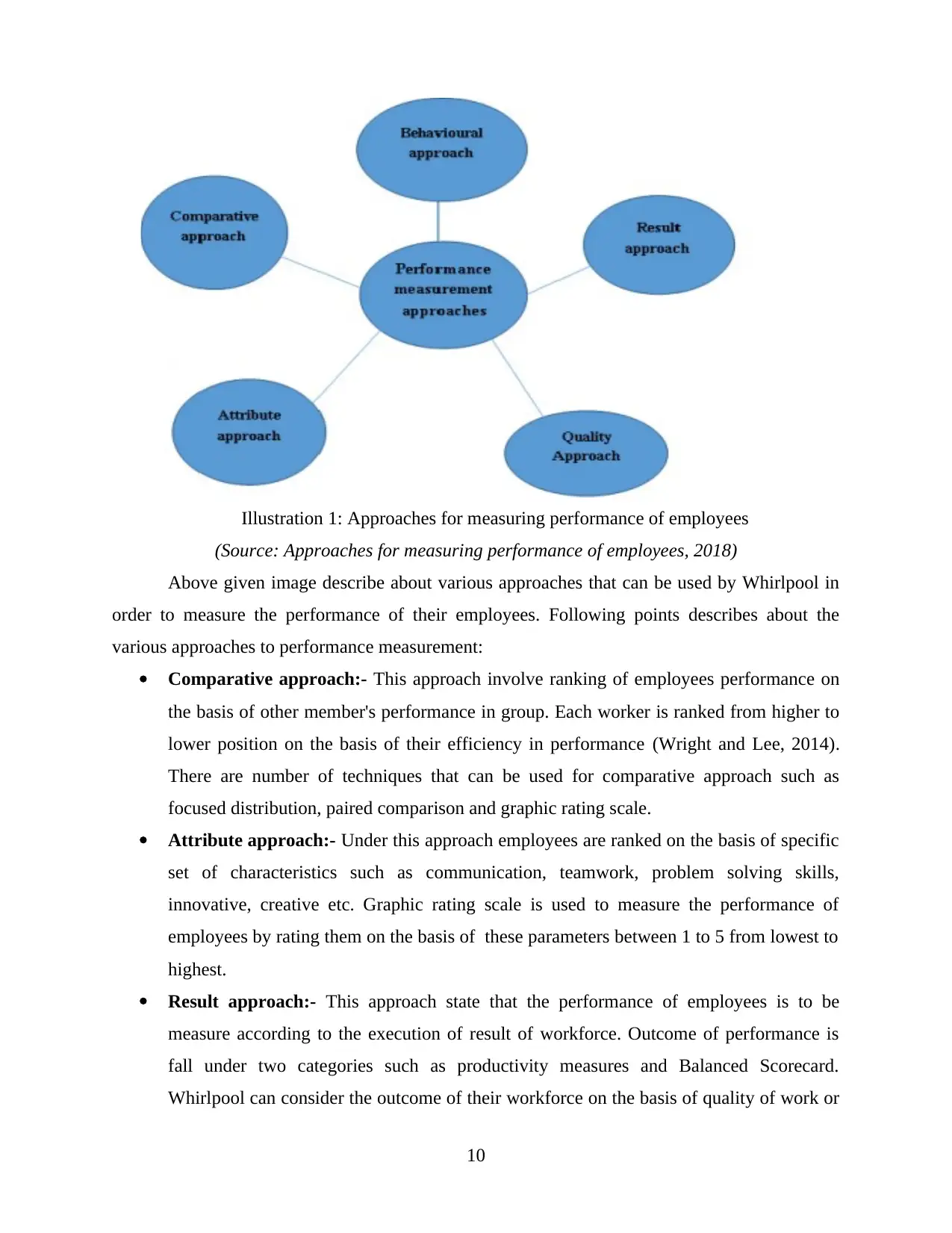
(Source: Approaches for measuring performance of employees, 2018)
Above given image describe about various approaches that can be used by Whirlpool in
order to measure the performance of their employees. Following points describes about the
various approaches to performance measurement:
Comparative approach:- This approach involve ranking of employees performance on
the basis of other member's performance in group. Each worker is ranked from higher to
lower position on the basis of their efficiency in performance (Wright and Lee, 2014).
There are number of techniques that can be used for comparative approach such as
focused distribution, paired comparison and graphic rating scale.
Attribute approach:- Under this approach employees are ranked on the basis of specific
set of characteristics such as communication, teamwork, problem solving skills,
innovative, creative etc. Graphic rating scale is used to measure the performance of
employees by rating them on the basis of these parameters between 1 to 5 from lowest to
highest.
Result approach:- This approach state that the performance of employees is to be
measure according to the execution of result of workforce. Outcome of performance is
fall under two categories such as productivity measures and Balanced Scorecard.
Whirlpool can consider the outcome of their workforce on the basis of quality of work or
10
Illustration 1: Approaches for measuring performance of employees
Above given image describe about various approaches that can be used by Whirlpool in
order to measure the performance of their employees. Following points describes about the
various approaches to performance measurement:
Comparative approach:- This approach involve ranking of employees performance on
the basis of other member's performance in group. Each worker is ranked from higher to
lower position on the basis of their efficiency in performance (Wright and Lee, 2014).
There are number of techniques that can be used for comparative approach such as
focused distribution, paired comparison and graphic rating scale.
Attribute approach:- Under this approach employees are ranked on the basis of specific
set of characteristics such as communication, teamwork, problem solving skills,
innovative, creative etc. Graphic rating scale is used to measure the performance of
employees by rating them on the basis of these parameters between 1 to 5 from lowest to
highest.
Result approach:- This approach state that the performance of employees is to be
measure according to the execution of result of workforce. Outcome of performance is
fall under two categories such as productivity measures and Balanced Scorecard.
Whirlpool can consider the outcome of their workforce on the basis of quality of work or
10
Illustration 1: Approaches for measuring performance of employees
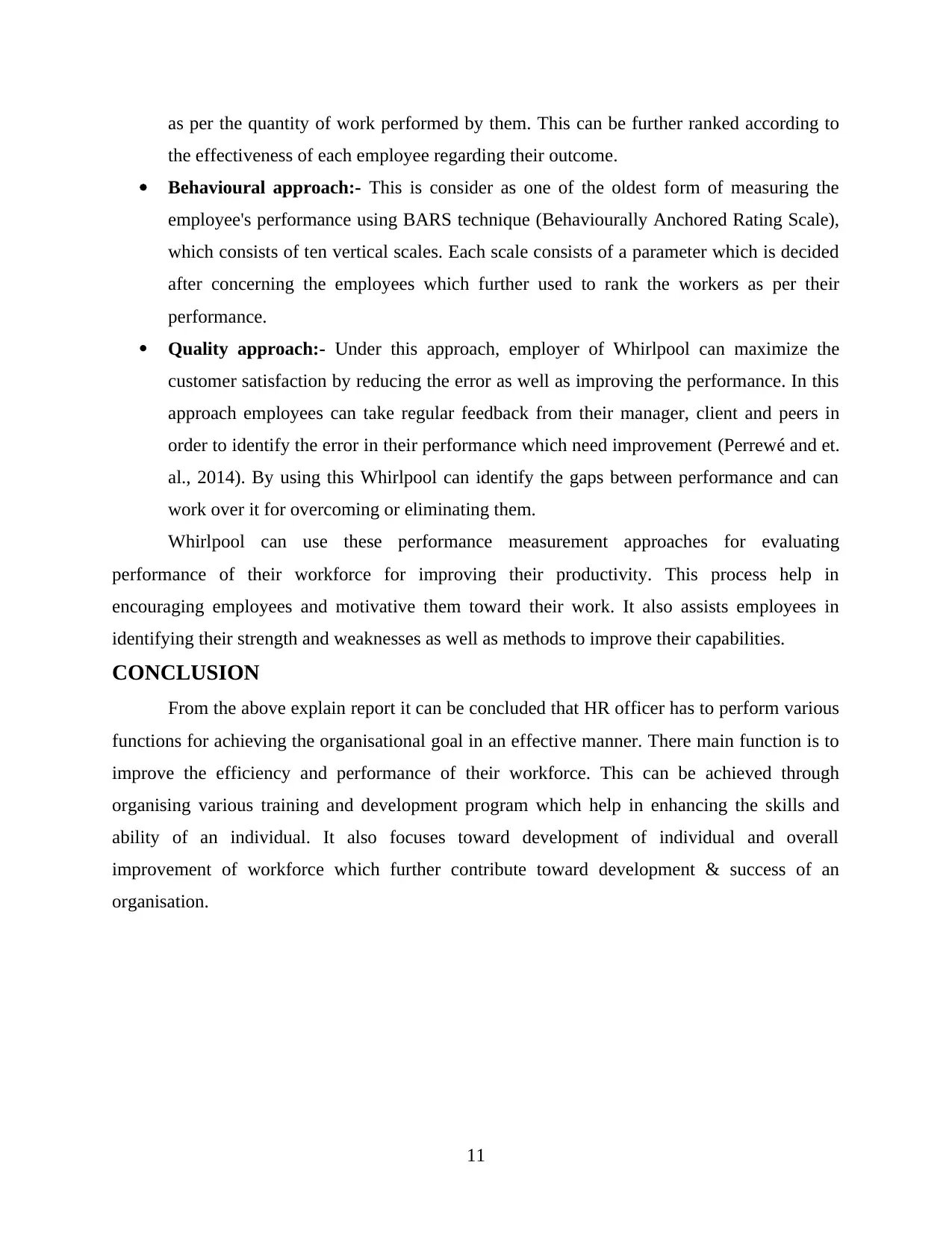
as per the quantity of work performed by them. This can be further ranked according to
the effectiveness of each employee regarding their outcome.
Behavioural approach:- This is consider as one of the oldest form of measuring the
employee's performance using BARS technique (Behaviourally Anchored Rating Scale),
which consists of ten vertical scales. Each scale consists of a parameter which is decided
after concerning the employees which further used to rank the workers as per their
performance.
Quality approach:- Under this approach, employer of Whirlpool can maximize the
customer satisfaction by reducing the error as well as improving the performance. In this
approach employees can take regular feedback from their manager, client and peers in
order to identify the error in their performance which need improvement (Perrewé and et.
al., 2014). By using this Whirlpool can identify the gaps between performance and can
work over it for overcoming or eliminating them.
Whirlpool can use these performance measurement approaches for evaluating
performance of their workforce for improving their productivity. This process help in
encouraging employees and motivative them toward their work. It also assists employees in
identifying their strength and weaknesses as well as methods to improve their capabilities.
CONCLUSION
From the above explain report it can be concluded that HR officer has to perform various
functions for achieving the organisational goal in an effective manner. There main function is to
improve the efficiency and performance of their workforce. This can be achieved through
organising various training and development program which help in enhancing the skills and
ability of an individual. It also focuses toward development of individual and overall
improvement of workforce which further contribute toward development & success of an
organisation.
11
the effectiveness of each employee regarding their outcome.
Behavioural approach:- This is consider as one of the oldest form of measuring the
employee's performance using BARS technique (Behaviourally Anchored Rating Scale),
which consists of ten vertical scales. Each scale consists of a parameter which is decided
after concerning the employees which further used to rank the workers as per their
performance.
Quality approach:- Under this approach, employer of Whirlpool can maximize the
customer satisfaction by reducing the error as well as improving the performance. In this
approach employees can take regular feedback from their manager, client and peers in
order to identify the error in their performance which need improvement (Perrewé and et.
al., 2014). By using this Whirlpool can identify the gaps between performance and can
work over it for overcoming or eliminating them.
Whirlpool can use these performance measurement approaches for evaluating
performance of their workforce for improving their productivity. This process help in
encouraging employees and motivative them toward their work. It also assists employees in
identifying their strength and weaknesses as well as methods to improve their capabilities.
CONCLUSION
From the above explain report it can be concluded that HR officer has to perform various
functions for achieving the organisational goal in an effective manner. There main function is to
improve the efficiency and performance of their workforce. This can be achieved through
organising various training and development program which help in enhancing the skills and
ability of an individual. It also focuses toward development of individual and overall
improvement of workforce which further contribute toward development & success of an
organisation.
11
Paraphrase This Document
Need a fresh take? Get an instant paraphrase of this document with our AI Paraphraser
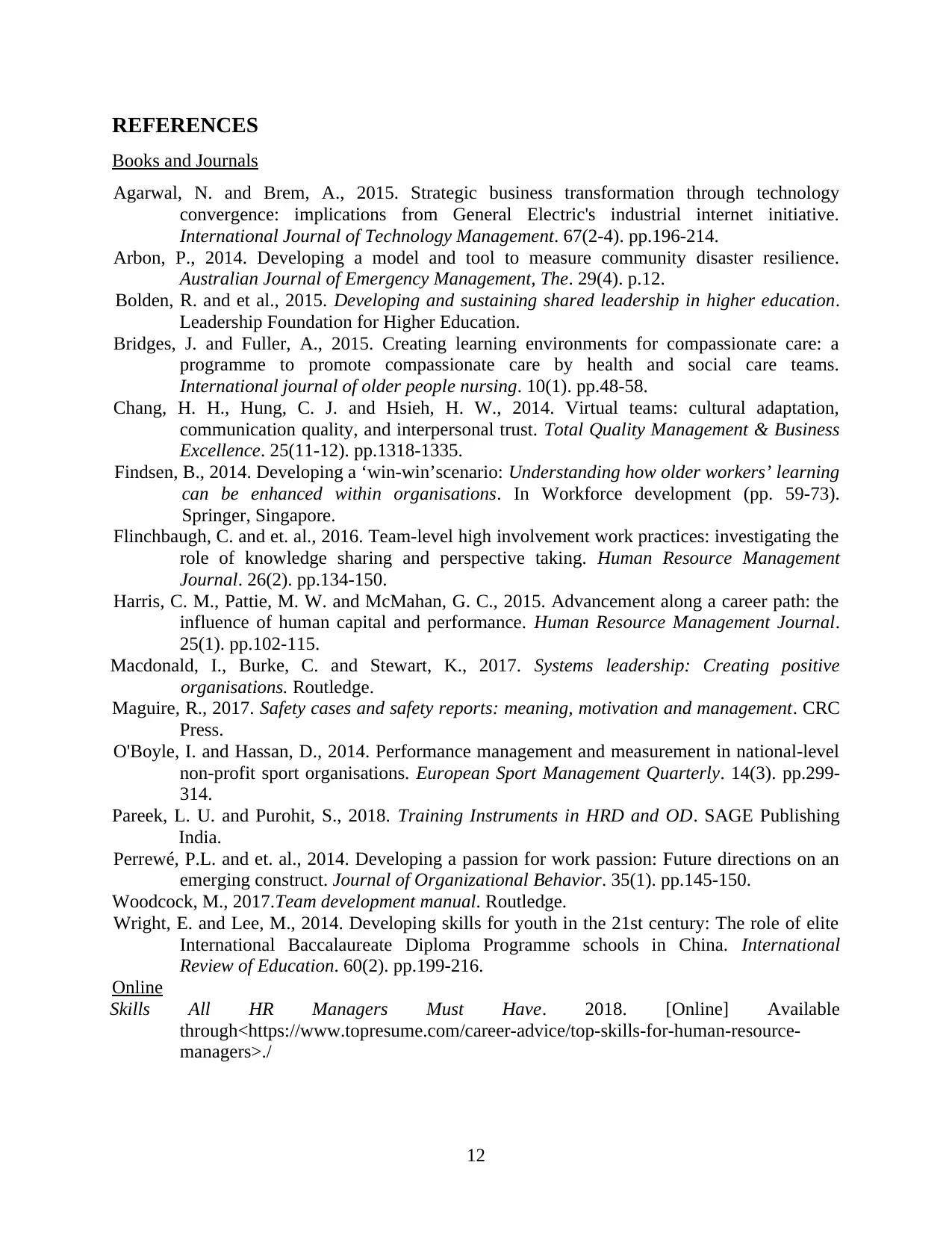
REFERENCES
Books and Journals
Agarwal, N. and Brem, A., 2015. Strategic business transformation through technology
convergence: implications from General Electric's industrial internet initiative.
International Journal of Technology Management. 67(2-4). pp.196-214.
Arbon, P., 2014. Developing a model and tool to measure community disaster resilience.
Australian Journal of Emergency Management, The. 29(4). p.12.
Bolden, R. and et al., 2015. Developing and sustaining shared leadership in higher education.
Leadership Foundation for Higher Education.
Bridges, J. and Fuller, A., 2015. Creating learning environments for compassionate care: a
programme to promote compassionate care by health and social care teams.
International journal of older people nursing. 10(1). pp.48-58.
Chang, H. H., Hung, C. J. and Hsieh, H. W., 2014. Virtual teams: cultural adaptation,
communication quality, and interpersonal trust. Total Quality Management & Business
Excellence. 25(11-12). pp.1318-1335.
Findsen, B., 2014. Developing a ‘win-win’scenario: Understanding how older workers’ learning
can be enhanced within organisations. In Workforce development (pp. 59-73).
Springer, Singapore.
Flinchbaugh, C. and et. al., 2016. Team‐level high involvement work practices: investigating the
role of knowledge sharing and perspective taking. Human Resource Management
Journal. 26(2). pp.134-150.
Harris, C. M., Pattie, M. W. and McMahan, G. C., 2015. Advancement along a career path: the
influence of human capital and performance. Human Resource Management Journal.
25(1). pp.102-115.
Macdonald, I., Burke, C. and Stewart, K., 2017. Systems leadership: Creating positive
organisations. Routledge.
Maguire, R., 2017. Safety cases and safety reports: meaning, motivation and management. CRC
Press.
O'Boyle, I. and Hassan, D., 2014. Performance management and measurement in national-level
non-profit sport organisations. European Sport Management Quarterly. 14(3). pp.299-
314.
Pareek, L. U. and Purohit, S., 2018. Training Instruments in HRD and OD. SAGE Publishing
India.
Perrewé, P.L. and et. al., 2014. Developing a passion for work passion: Future directions on an
emerging construct. Journal of Organizational Behavior. 35(1). pp.145-150.
Woodcock, M., 2017.Team development manual. Routledge.
Wright, E. and Lee, M., 2014. Developing skills for youth in the 21st century: The role of elite
International Baccalaureate Diploma Programme schools in China. International
Review of Education. 60(2). pp.199-216.
Online
Skills All HR Managers Must Have. 2018. [Online] Available
through<https://www.topresume.com/career-advice/top-skills-for-human-resource-
managers>./
12
Books and Journals
Agarwal, N. and Brem, A., 2015. Strategic business transformation through technology
convergence: implications from General Electric's industrial internet initiative.
International Journal of Technology Management. 67(2-4). pp.196-214.
Arbon, P., 2014. Developing a model and tool to measure community disaster resilience.
Australian Journal of Emergency Management, The. 29(4). p.12.
Bolden, R. and et al., 2015. Developing and sustaining shared leadership in higher education.
Leadership Foundation for Higher Education.
Bridges, J. and Fuller, A., 2015. Creating learning environments for compassionate care: a
programme to promote compassionate care by health and social care teams.
International journal of older people nursing. 10(1). pp.48-58.
Chang, H. H., Hung, C. J. and Hsieh, H. W., 2014. Virtual teams: cultural adaptation,
communication quality, and interpersonal trust. Total Quality Management & Business
Excellence. 25(11-12). pp.1318-1335.
Findsen, B., 2014. Developing a ‘win-win’scenario: Understanding how older workers’ learning
can be enhanced within organisations. In Workforce development (pp. 59-73).
Springer, Singapore.
Flinchbaugh, C. and et. al., 2016. Team‐level high involvement work practices: investigating the
role of knowledge sharing and perspective taking. Human Resource Management
Journal. 26(2). pp.134-150.
Harris, C. M., Pattie, M. W. and McMahan, G. C., 2015. Advancement along a career path: the
influence of human capital and performance. Human Resource Management Journal.
25(1). pp.102-115.
Macdonald, I., Burke, C. and Stewart, K., 2017. Systems leadership: Creating positive
organisations. Routledge.
Maguire, R., 2017. Safety cases and safety reports: meaning, motivation and management. CRC
Press.
O'Boyle, I. and Hassan, D., 2014. Performance management and measurement in national-level
non-profit sport organisations. European Sport Management Quarterly. 14(3). pp.299-
314.
Pareek, L. U. and Purohit, S., 2018. Training Instruments in HRD and OD. SAGE Publishing
India.
Perrewé, P.L. and et. al., 2014. Developing a passion for work passion: Future directions on an
emerging construct. Journal of Organizational Behavior. 35(1). pp.145-150.
Woodcock, M., 2017.Team development manual. Routledge.
Wright, E. and Lee, M., 2014. Developing skills for youth in the 21st century: The role of elite
International Baccalaureate Diploma Programme schools in China. International
Review of Education. 60(2). pp.199-216.
Online
Skills All HR Managers Must Have. 2018. [Online] Available
through<https://www.topresume.com/career-advice/top-skills-for-human-resource-
managers>./
12
1 out of 14
Related Documents
Your All-in-One AI-Powered Toolkit for Academic Success.
+13062052269
info@desklib.com
Available 24*7 on WhatsApp / Email
![[object Object]](/_next/static/media/star-bottom.7253800d.svg)
Unlock your academic potential
© 2024 | Zucol Services PVT LTD | All rights reserved.





